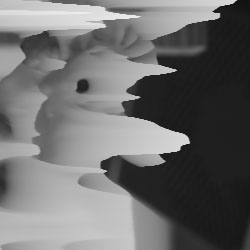Each pixel in the CCD has a certain capacity for charge, usually a few hundred thousand electrons. When this capacity is exceed it is referred to as saturation. If saturation occurs during exposure it is the capcity of the image area pixel that is exceed and the familiar parallel saturation occurs. It is also possible to exceed the capacity of the serial register pixels as well. When this occurs charge begins to spill along the serial register (usually the horizontal direction in the display).
In most CCD's the capacity of the serial register pixels is designed to be twice the capacity of the parallel register pixels. Thus in some CCD's it is possible to exceed the charge capacity of the serial register with binning by three or more in the parallel direction, but it should occur near the saturation level of the A/D converter. If the value of the pixels in the smeared area is near 4095 for a 12bit camera or 65535 for a 16bit camera then it may be operating correctly. If it occurs at a much lower level there is certainly a problem.
This is usually an adjustment issue in the camera and can be corrected by the camera manufacturer. Return the camera for service.
